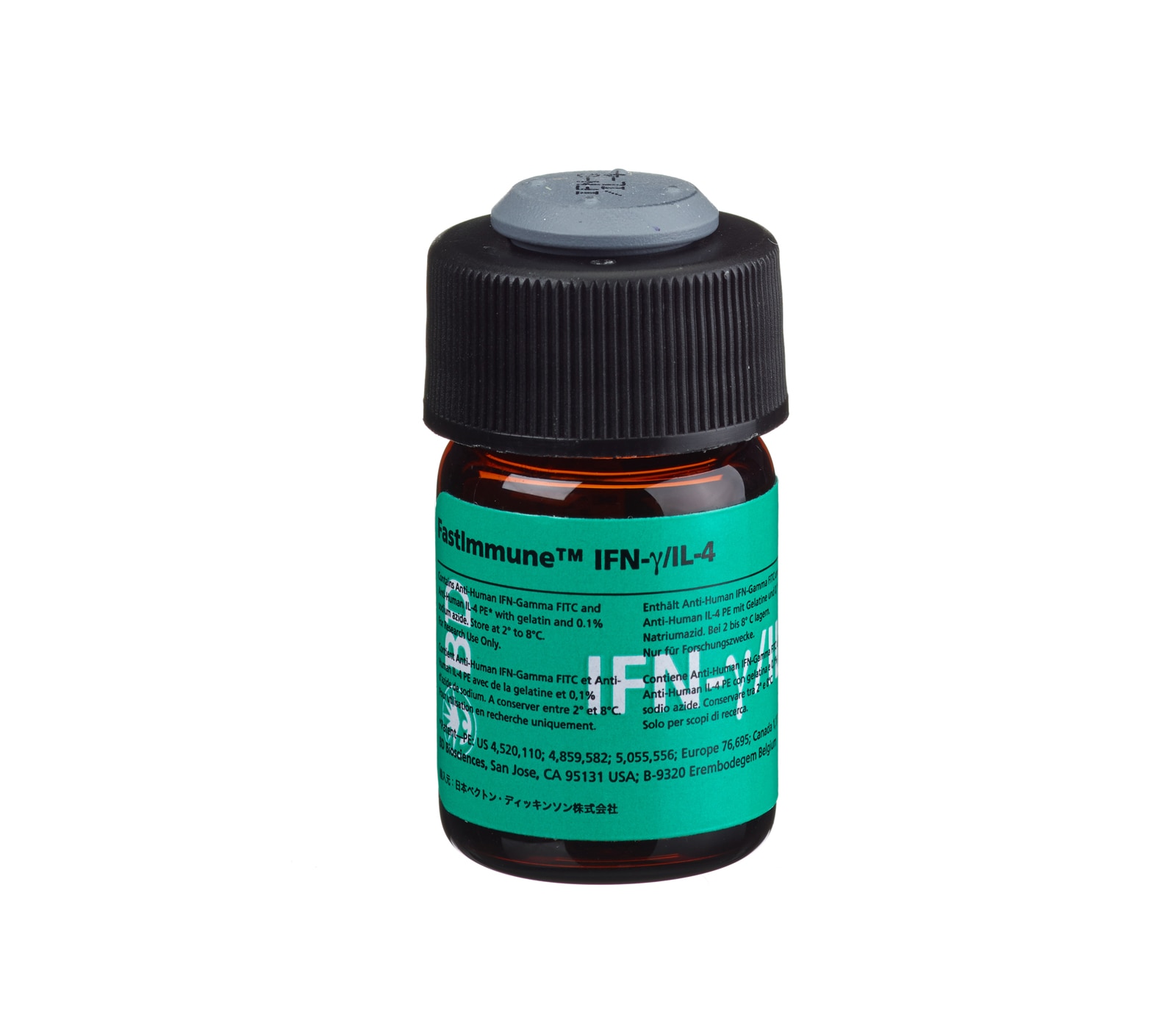Old Browser
This page has been recently translated and is available in French now.
Looks like you're visiting us from {countryName}.
Would you like to stay on the current country site or be switched to your country?
BD FastImmune™ Anti-Human IFN-γ FITC/IL-4 PE
(RUO (GMP))

Anti-Human IFN-γ FITC/IL-4 PE
Regulatory Status Legend
Any use of products other than the permitted use without the express written authorization of Becton, Dickinson and Company is strictly prohibited.
Description
The Anti-Hu–IFN-γ antibody, clone 25723.11, is derived from the hybridization of P3X-63-Ag8.653 mouse myeloma cells with lymph node cells from BALB/c mice immunized with recombinant human IFN-γ. The Anti-Hu–IL-4 antibody, clone 3010.211, is derived from the hybridization of Sp2/0 mouse cells with the spleen cells from BALB/c mice immunized with recombinant human IL-4. The Anti-Human Interferon-γ (Anti-Hu–IFN-γ) antibody recognizes a 20- to 25-kilodalton (kDa) glycoprotein. Anti-Human Interleukin-4 (Anti-Hu–IL-4) recognizes a 15- to 19-kDa glycoprotein.
Preparation And Storage
Store vials at 2°C–8°C. Conjugated forms should not be frozen. Protect from exposure to light. Each reagent is stable until the expiration date shown on the bottle label when stored as directed.
| Description | Clone | Isotype | EntrezGene ID |
|---|---|---|---|
| IFN-γ FITC | TgMab-2 | IgG1, κ | N/A |
| IL-4 PE | 3010.211 | IgG1, | N/A |
Development References (15)
-
Aggarwal B, Puri R. Human Cytokines: Their Role in Disease and Therapy. Cambridge, MA: Blackwell Science; 1995:3-24.
-
Bradding P, Feather IH, Howarth PH, et al. Interleukin 4 is localized to and released by human mast cells. J Exp Med. 1992; 176:1381-1386. (Biology).
-
Centers for Disease Control. Update: universal precautions for prevention of transmission of human immunodeficiency virus, hepatitis B virus, and other bloodborne pathogens in healthcare settings. MMWR. 1988; 37:377-388. (Biology).
-
Clinical and Laboratory Standards Institute. 2005. (Biology).
-
ElGhazali GEB, Paulie S, Andersson G, et al. Number of interleukin-4– and interferon- γ –secreting human T cells reactive with tetanus toxoid and the mycobacterial antigen PPD or phytohemagglutindistinct response profiles depending on the type of antigen used for activation. Eur J Immunol. 1993; 23:2740-2745. (Biology).
-
Elliott MJ, Gamble JR, Park LS, Vadas MA, Lopez AF. Inhibition of human monocyte adhesion by interleukin-4. Blood. 1991; 77:2739-2745. (Biology).
-
Hardy KJ, Sawada T. Human γ interferon strongly upregulates its own gene expression in peripheral blood lymphocytes. J Exp Med. 1989; 170:1021-1026. (Biology).
-
Idzerda RL, March CJ, Mosley B, et al. Human interleukin 4 receptor confers biological responsiveness and defines a novel receptor superfamily. J Exp Med. 1990; 171(3):861-873. (Biology). View Reference
-
Johnson HM, Bazer FW, Szente BE, Jarpe MA. How interferons fight disease. Scientific American. 1994; May:68-75. (Biology).
-
Openshaw P, Murphy EE, Hosken NA, et al. Heterogeneity of intracellular cytokine synthesis at the single-cell level in polarized T helper 1 and T helper 2 populations. J Exp Med. 1995; 182(5):1357-1367. (Biology). View Reference
-
Paliard X, Malefijt RDW, Yssel H, et al. Simultaneous production of IL-2, IL-4, and IFN-γ by activated human CD4+ and CD8+ T cell clones. J Immunol. 1988; 141:849-855. (Biology).
-
Paul WE. Interleukin-4: a prototypic immunoregulatory lymphokine. Blood. 1991; 77(9):1859-1870. (Biology). View Reference
-
Powrie F, Coffman RL. Cytokine regulation of T-cell function: potential for therapeutic intervention. Immunol Today. 1993; 14:270-274. (Biology).
-
Romagnani S, Del Prete G, Maggi E, et al. Human TH1 and TH2 subsets. Int Arch Allergy Immunol. 1992; 99:242-245. (Biology).
-
Street NE, Mosmann TR. Functional diversity of T lymphocytes due to secretion of different cytokine patterns. FASEB J. 1991; 5:171-176. (Biology).
Please refer to Support Documents for Quality Certificates
Global - Refer to manufacturer's instructions for use and related User Manuals and Technical data sheets before using this products as described
Comparisons, where applicable, are made against older BD Technology, manual methods or are general performance claims. Comparisons are not made against non-BD technologies, unless otherwise noted.
For Research Use Only. Not for use in diagnostic or therapeutic procedures.
Although not required, these products are manufactured in accordance with Good Manufacturing Practices.
Report a Site Issue
This form is intended to help us improve our website experience. For other support, please visit our Contact Us page.